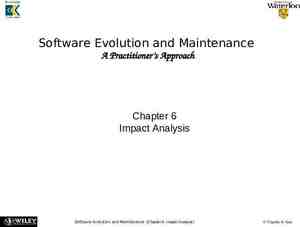Lectures 2 & 3 Software Processes Software Engineering, COMP201
50 Slides498.00 KB
Lectures 2 & 3 Software Processes Software Engineering, COMP201 Slide 1
What is a Process ? When we provide a service or create a product we always follow a sequence of steps to accomplish a set of tasks You do not usually » put up the drywall before the wiring for a house is installed or » bake a cake before all the ingredients are mixed together We can think of a series of activities as a process Any process has the following characteristics It prescribes all of the major activities It uses resources and produces intermediate and final products It may include sub-processes and has entry and exit criteria The activities are organized in a sequence Constrains or control may apply to activities (budget control, availability of resources ) Software Engineering, COMP201 Slide 2
Software Processes When the process involves the building of some product we refer to the process as a life cycle Software development process – software life cycle Coherent sets of activities for Specifying, Designing, Implementing and Testing software systems Software Engineering, COMP201 Slide 3
Major problems in software developments The requirements specification was defined like this The developers understood it in that way That is the program after debugging This is how the problem was solved before. This is how the program is described by marketing department Software Engineering, COMP201 This is how the problem is solved now This, in fact, is what the customer wanted ;-) Slide 4
The Software Process A structured set of activities required to develop a software system Specification Design Validation Evolution A software process model is an abstract representation of a process It presents a description of a process from some particular perspective Software Engineering, COMP201 Slide 5
Generic Software Process Models The waterfall model Evolutionary development Specification and development are interleaved Formal systems development (example - ASML) Separate and distinct phases of specification and development A mathematical system model is formally transformed to an implementation Reuse-based development The system is assembled from existing components Software Engineering, COMP201 Slide 6
1. Waterfall Model Requirements definition System and software design Implementation and unit testing Integr ation and system testing Operation and maintenance Software Engineering, COMP201 Slide 7
Waterfall model phases Requirements analysis and definition System and software design Implementation and unit testing Integration and system testing Operation and maintenance The drawback of the waterfall model is the difficulty of accommodating change after the process is underway Software Engineering, COMP201 Slide 8
Waterfall model problems Inflexible partitioning of the project into distinct stages This makes it difficult to respond to changing customer requirements Therefore, this model is only appropriate when the requirements are well-understood Waterfall model describes a process of stepwise refinement Based on hardware engineering models Widely used in military and aerospace industries Software Engineering, COMP201 Slide 9
Why Not a Waterfall But software is different : No fabrication step Program code is another design level Hence, no “commit” step – software can always be changed ! No body of experience for design analysis (yet) Most analysis (testing) is done on program code Hence, problems not detected until late in the process Waterfall model takes a static view of requirements Ignore changing needs Lack of user involvement once specification is written Unrealistic separation of specification from the design Doesn’t accommodate prototyping, reuse, etc Software Engineering, COMP201 Slide 10
2. Evolutionary development Exploratory development - Objective is to work with customers and to evolve a final system from an initial outline specification. Should start with well-understood requirements. The system evolves by adding new features as they are proposed by customer. Throw-away prototyping Objective is to understand the system requirements. Should start with poorly understood requirements » Develop “quick and dirty” system quickly; » Expose to user comment; » Refine; Until adequate system developed. Particularly suitable where: - detailed requirements not possible; - powerful development tools (e.g. GUI) available Software Engineering, COMP201 Slide 11
Evolutionary development Concurr ent activities Outline description Specification Initial version Development Intermediate versions Validation Final version Software Engineering, COMP201 Slide 12
Evolutionary development Problems Lack of process visibility Systems are often poorly structured Special skills (e.g. in languages for rapid prototyping) may be required Applicability For small or medium-size interactive systems For parts of large systems (e.g. the user interface) For short-lifetime systems Software Engineering, COMP201 Slide 13
3. Formal systems development Based on the transformation of a mathematical specification through different representations to an executable program Transformations are ‘correctness-preserving’ so it is straightforward to show that the program conforms to its specification Embodied in the ‘Cleanroom’ approach (which was originally developed by IBM) to software development Software Engineering, COMP201 Slide 14
Formal systems development Requirements definition Formal specification Formal transformation Software Engineering, COMP201 Integration and system testing Slide 15
Formal transformations Formal transformations T1 Formal specification T2 R1 P1 T3 R2 P2 T4 Executable program R3 P3 P4 Proofs of transformation correctness Software Engineering, COMP201 Slide 16
Formal systems development Problems Need for specialised skills and training to apply the technique Difficult to formally specify some aspects of the system such as the user interface Applicability Critical systems especially those where a safety or security case must be made before the system is put into operation Software Engineering, COMP201 Slide 17
4. Reuse-oriented development Based on systematic reuse where systems are integrated from existing components or COTS (Commercial-off-the-shelf) systems Process stages Component analysis Requirements modification System design with reuse Development and integration This approach is becoming more important but still limited experience with it Software Engineering, COMP201 Slide 18
Reuse-oriented development Requirements specification Component analysis Requirements modification System design with reuse Development and integration Software Engineering, COMP201 System validation Slide 19
Process iteration Modern development processes take iteration as fundamental, and try to provide ways of managing, rather than ignoring, the risk System requirements ALWAYS evolve in the course of a project so process iteration where earlier stages are reworked is always part of the process for large systems Iteration can be applied to any of the generic process models Two (related) approaches Incremental development Spiral development Software Engineering, COMP201 Slide 20
5. Incremental development Rather than deliver the system as a single delivery, the development and delivery is broken down into increments with each increment delivering part of the required functionality User requirements are prioritised and the highest priority requirements are included in early increments Once the development of an increment is started, the requirements are frozen though requirements for later increments can continue to evolve Software Engineering, COMP201 Slide 21
Incremental development Define outline requirements Develop system increment Assign requirements to increments Valida te increment Design system architecture Integrate increment Valida te system Final system System incomplete Software Engineering, COMP201 Slide 22
Incremental development advantages Customer value can be delivered with each increment so system functionality is available earlier Early increments act as a prototype to help elicit requirements for later increments Lower risk of overall project failure The highest priority system services tend to receive the most testing Software Engineering, COMP201 Slide 23
Extreme programming New approach to development based on the development and delivery of very small increments of functionality Relies on constant code improvement, user involvement in the development team and pairwise programming Design of the test suits first ! Then you perform testing of the system after each small increment Software Engineering, COMP201 Slide 24
6. Spiral development Process is represented as a spiral rather than as a sequence of activities with backtracking Each loop in the spiral represents a phase in the process. No fixed phases such as specification or design loops in the spiral are chosen depending on what is required Risks are explicitly assessed and resolved throughout the process Software Engineering, COMP201 Slide 25
Spiral model of the software process Determine objectives alternatives and constraints Risk analysis Evaluate alternatives identify, resolve risks Risk analysis Risk analysis REVIEW Requirements plan Life-cycle plan Development plan Plan next phase Integration and test plan Prototype 3 Prototype 2 Operational protoype Risk analysis Prototype 1 Simulations, models, benchmarks Concept of Operation S/W requirements Requirement validation Product design Detailed design Code Unit test Design V&V Integr ation test Acceptance test Develop, verify Service next-level product Software Engineering, COMP201 Slide 26
Spiral model sectors Objective setting Risk assessment and reduction Risks are assessed and activities put in place to reduce the key risks Development and validation Specific objectives for the phase are identified A development model for the system is chosen which can be any of the generic models Planning The project is reviewed and the next phase of the spiral is planned Software Engineering, COMP201 Slide 27
I. Software specification The process of establishing what services are required and the constraints on the system’s operation and development Requirements engineering process Feasibility study Requirements elicitation and analysis Requirements specification Requirements validation Software Engineering, COMP201 Slide 28
The requirements engineering process Feasibility study Requirements elicitation and analysis Requir ements specification Feasibility report Requirements validation System models User and system requirements Requirements document Software Engineering, COMP201 Slide 29
II. Software design and implementation The process of converting the system specification into an executable system Software design Implementation Design a software structure that realises the specification Translate this structure into an executable program The activities of design and implementation are closely related and may be inter-leaved Software Engineering, COMP201 Slide 30
Design process activities Architectural design Abstract specification Interface design Component design Data structure design Algorithm design Software Engineering, COMP201 Slide 31
The software design process Requirements specification Design acti vities Architectur al design Abstract specification Interface design Component design Data structur e design Algorithm design System architectur e Software specification Interface specification Component specification Data structur e specification Algorithm specification Design pr oducts Software Engineering, COMP201 Slide 32
Design methods Systematic approaches to developing a software design The design is usually documented as a set of graphical models Possible models Data-flow model Entity-relation-attribute model Structural model Object models Software Engineering, COMP201 Slide 33
Programming and debugging Translating a design into a program and removing errors from that program Programming is a personal activity - there is no generic programming process Programmers carry out some program testing to discover faults in the program and remove these faults in the debugging process Software Engineering, COMP201 Slide 34
The debugging process Locate error Design error repair Repair error Software Engineering, COMP201 Re-test program Slide 35
III Software validation Verification and validation is intended to show that a system conforms to its specification and meets the requirements of the system customer Involves checking and review processes and system testing System testing involves executing the system with test cases that are derived from the specification of the real data to be processed by the system Software Engineering, COMP201 Slide 36
The testing process Unit testing Module testing Sub-system testing System testing Acceptance testing Component testing Integration testing Software Engineering, COMP201 User testing Slide 37
Testing stages Unit testing Module testing Modules are integrated into sub-systems and tested. The focus here should be on interface testing System testing Related collections of dependent components are tested Sub-system testing Individual components are tested Testing of the system as a whole. Testing of emergent properties Acceptance testing Testing with customer data to check that it is acceptable Software Engineering, COMP201 Slide 38
Testing phases Requir ements specification System specification System integration test plan Acceptance test plan Service System design Acceptance test Detailed design Sub-system integration test plan System integration test Software Engineering, COMP201 Module and unit code and tess Sub-system integration test Slide 39
IV Software evolution Software is inherently flexible and can change. As requirements change through changing business circumstances, the software that supports the business must also evolve and change Although there has been a demarcation between development and evolution (maintenance) this is increasingly irrelevant as fewer and fewer systems are completely new Software Engineering, COMP201 Slide 40
System evolution Define system requirements Assess existing systems Propose system changes Existing systems Modify systems New system Software Engineering, COMP201 Slide 41
Automated process support (CASE) Computer-aided software engineering (CASE) is software to support software development and evolution processes Activity automation Graphical editors for system model development Data dictionary to manage design entities Graphical UI builder for user interface construction Debuggers to support program fault finding Automated translators to generate new versions of a program Software Engineering, COMP201 Slide 42
Case technology Case technology has led to significant improvements in the software process though not the order of magnitude improvements that were once predicted Software engineering requires creative thought this is not readily automatable Software engineering is a team activity and, for large projects, much time is spent in team interactions. CASE technology does not really support these Software Engineering, COMP201 Slide 43
CASE classification Classification helps us understand the different types of CASE tools and their support for process activities Functional perspective Process perspective Tools are classified according to their specific function Tools are classified according to process activities that are supported Integration perspective Tools are classified according to their organisation into integrated units Software Engineering, COMP201 Slide 44
Functional tool classification Software Engineering, COMP201 Slide 45
Reengineering tools Testing tools Debugging tools Program analysis tools Language-processing tools Method support tools Prototyping tools Configuration management tools Change management tools Documentation tools Editing tools Planning tools Specification Design Activity-based classification Implementation Verification and Validation
CASE integration Tools Support individual process tasks such as design consistency checking, text editing, etc. Workbenches Support a process phase such as specification or design, Normally include a number of integrated tools Environments Support all or a substantial part of an entire software process. Normally include several integrated workbenches Software Engineering, COMP201 Slide 47
Tools, workbenches, environments CASE technology Tools Editors Compilers Workbenches File comparators Analysis and design Multi-method workbenches Integrated environments Programming Single-method workbenches Environments Testing General-purpose workbenches Software Engineering, COMP201 Process-centred environments Language-specific workbenches Slide 48
Key points Software processes are the activities involved in producing and evolving a software system. They are represented in a software process model General activities are specification, design and implementation, validation and evolution Generic process models describe the organisation of software processes Iterative process models describe the software process as a cycle of activities Software Engineering, COMP201 Slide 49
Key points Requirements engineering is the process of developing a software specification Design and implementation processes transform the specification to an executable program Validation involves checking that the system meets to its specification and user needs Evolution is concerned with modifying the system after it is in use CASE technology supports software process activities Software Engineering, COMP201 Slide 50























































